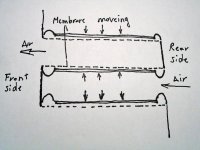Is this begining of new age in bass drivers? Bye , bye cone shape.
This is very interesting driver , for now reserved only for big fishes
Tymphany tech.
This is very interesting driver , for now reserved only for big fishes

Tymphany tech.
Attachments
Bill Fitzpatrick said:I suppose it has it's place. Not for me though.
Indeed
Gasho said:Why ?
Have you seen that thing!, UGLY. Besides I like my normal cone drivers.
Are you buying drivers by their beauty5th element said:Have you seen that thing!, UGLY. Besides I like my normal cone drivers. [/B]
 ?
?I simlpy adore non conventional drivers like this one.
I can´t wait until they come on market
This is going to be a killer high-end bass driver.


Gasho said:Why ?
Because my 2, 8 cu.ft. enclosures are occupying space that I wouldn't otherwise use.
Gasho said:
This is going to be a killer high-end bass driver.
I doubt it.
Have you overlooked the fact that these things need enclosures too?
So what? The principe of desig is superior to standard large cone drivers , an is much smaller , without cone distorsion and mass. The enclosure is needed in all bass designes , the internal shape,rigidity , lack of reflections bla,bla , that is important for good refproductionBill Fitzpatrick said:
I doubt it.
Have you overlooked the fact that these things need enclosures too?
Why are you so conservative

Attachments
Bill Fitzpatrick said:Have you overlooked the fact that these things need enclosures too?
Why? The bigger LATs, IMO, would make PERFECT dipole drivers. You could use them as speaker stands for decent-sized bookshelf speakers (e.g. Adire HE10.1), or stack a bunch of the small ones for a dipole line array that would have significantly more Vd than an equivalent-width column of cone drivers.
Or how about an I-B install with a giant LAT (or LAT array) mounted between two studs? Again, more Vd with less effort. Square holes are (marginally) easier to cut than round ones.
IMO, the LAT is not going to replace the cone woofer, but the columnar form factor will offer interesting new ways to get lots of bass in home and especially car systems.
Pallas said:
Or how about an I-B install with a giant LAT (or LAT array) mounted between two studs? Again, more Vd with less effort. Square holes are (marginally) easier to cut than round ones.
Are we talking square holes for flush mounting or not? A circular driver is 1000x easier for me to flush mount then a square driver.
The way I understand it is that air can flow out between those slots we can see on the front which allow us access to the visable cones. Now the way I see it is that there are slots in the same place but on the back allowing air to flow out also as very poorly highlighted in the altered picture I have added.
Or are the other slots on the back not parallel with the ones on the front but moved down (or up) so that they correspond with the other side of the individual cones?
Or are the other slots on the back not parallel with the ones on the front but moved down (or up) so that they correspond with the other side of the individual cones?
Attachments
Gasho said:Do you undrstand how do they work?? I don´t think so.
There are not air transparent between front and rear side. The rear holes are separated from front ones by many membranes, that moves vertialcally i push-pull configuration.
Crazy isn´t it???
C'mon girls....
Seriously, the principal is very much like Dr Heils Airmotion
Transformer but executed mechanicaly.
Cheers,
Terry
Yeah its what I drew in my second pic.
Now I know how this thing works it does look like it will be interesting, im thinking three ways made easy, no need for a wide baffle from a driver with a large diameter.
The middle driver in the data sheet will reach an f3 of 50 hz in a 40 litre sealed box with a Qtc of 0.707. The driver requires a 10cm wide cutout! I wonder what its xmax and distortion are like. But I bet they will be expensive.
The 91dB sensativity seems almost perfect too for matching lots of midbass units used as midranges when BS is factored in, lots of 86/87 sens midbass out there.
The little one doesnt seem to be much use for a bass application, and id rather use a normal cone driver for a mid application.
Now I know how this thing works it does look like it will be interesting, im thinking three ways made easy, no need for a wide baffle from a driver with a large diameter.
The middle driver in the data sheet will reach an f3 of 50 hz in a 40 litre sealed box with a Qtc of 0.707. The driver requires a 10cm wide cutout! I wonder what its xmax and distortion are like. But I bet they will be expensive.
The 91dB sensativity seems almost perfect too for matching lots of midbass units used as midranges when BS is factored in, lots of 86/87 sens midbass out there.
The little one doesnt seem to be much use for a bass application, and id rather use a normal cone driver for a mid application.
- Status
- This old topic is closed. If you want to reopen this topic, contact a moderator using the "Report Post" button.
- Home
- Loudspeakers
- Multi-Way
- Tymphany LAT (Line Array Transducer)
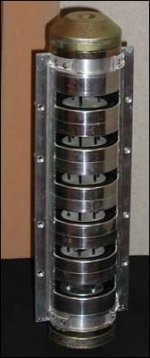
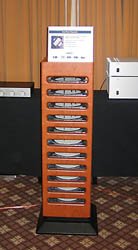
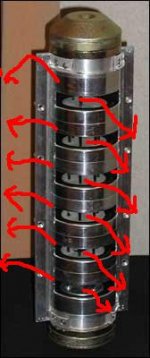
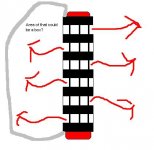
 I is very similar to AMT heil driver but with large number of pistons.
I is very similar to AMT heil driver but with large number of pistons.